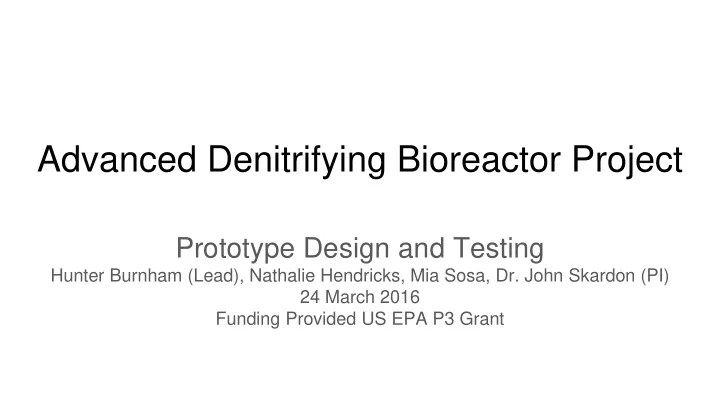

Advanced Denitrifying Bioreactor Project Prototype Design and Testing Hunter Burnham (Lead), Nathalie Hendricks, Mia Sosa, Dr. John Skardon (PI) 24 March 2016 Funding Provided US EPA P3 Grant
Acknowledgements to the CSUMB Bioreactor Team Students Faculty Justin Vivar Arlene Haffa, Ph.D. (Microbiology mentor) Teresa Munoz John Silveus, M.S. (Hydraulics mentor) Alexandra Ball Zane Mortensen California Biordi Alixandra Rachman
Basic Theory- Reduction of Nitrate to N 2 • In a compact bioreactor, we attempt to isolate facultative denitrifying bacteria from local sloughs and ponds, and grow large amounts of bacteria on a support matrix (plastic, ceramics, sand) • Some very common denitrifiying bacteria, such as P. stutzeri, can complete the the entire process shown below without release of substantial intermediate gases (GHGs) Source: http://wwwbrr.cr.usgs.gov/projects/EC_biogeochemistry/Cape.htm
Nitrate In Agricultural Tailwater- A Global Problem • Nutrient runoff is the largest unsolved water pollution problem globally • Salinas river is one of the most impacted rivers in the US • Currently, farmers and growers have no cost effective solution • Existing solutions are either too big and slow (woodchip bioreactors) or simply too expensive for farmers (ion exchange) • But denitrification is a well established and cost effective process in other industries. • So what’s the problem?
Market Failure and Government Failure? • If many industries can successfully denitrify wastewater, then the agriculture problem is not a technology problem but an innovation failure or “market failure” • Fining the growers, after we’ve all benefitted from California agriculture for decades, is not the solution • Rather, we need entrepreneurs to enter into this problem with support from the growers and “regulators” • The CSUMB bioreactor team is developing a solution that can be transferred to the private sector
Our Solution- Compact, Denitrifying Bioreactor • *Denitrification rate (DNR) > 600 grams of NO 3 -N per cubic-day, enables a very small footprint • Small footprint allows farmers to place the reactor as close to the source of tail-water as possible • Another benefit of close placement- higher denitrification rates at higher concentrations A 10 gallon-per-minute system (< 200 ft 2 ) • can be placed almost anywhere on the map (right) Utility scale denitrification systems routinely achieve DNR > 2kg NO 3 -N per cubic-day
Major Performance Goals for Prototype Denitrification rate > 600 g/m 3 -d @ 25 mg/L of NO 3 -N in wastewater • • Affects the footprint, high DNR allows flexible placement, consistent with other small aquaculture systems • Portable/Temporary • Ability to transport to grower site for weekly, monthly demonstrations • Maintainance- daily reactor cleaing (air sparging), refill carbon supply periodically • Grower cost: < $0.50 per 1000 gallons treated
Business Models (assumes a new private company has been formed) • Smaller growers- grow pays monthly fee for denitrification service • Larger growers- pay for design, install, and grower operates • Public-Private- county/state and grower share cost.
Project Design Features • Bacteria- Facultative denitrifying anaerobes, isolated from local slough or holding ponds. • Bacteria Support Matrix- plastic “bio-balls” with very high specific surface area (area/volume) • External carbon injection system with industry standard control system • Design- vertical up-flow, moving bed • Wireless/Cellular communication
Denitrifying Prototype Bioreactor 15’ System: ● Flow 2-5 GPM Variable ● HRT: Variable ● Power <500 Watts 10’ ● Supply tank (2.5- Buffer/Supply Tank DNR 3.5 K gal) 95” D + sump Tank ● Denitrifying Tank pump (DNR) 200-600 gal) ● External carbon supply (tote) + C Supply metering pump ● Footprint < 200 ft 2 ’ ● Foundation- packed dirt From Lift Station Overflow Drainage Ditch
Denitrification Rate- A Key Performance Indicator • Where: • DNR- denitrification rate, in grams of NO 3 -N removed/day-m 3 bed volume 𝚬 N = change in concentration from inlet to outlet, in grams NO 3 -N/m 3 • • FR= Flow rate, in cubic meters per day • Vbed= denitrification bed volume, in cubic meters See Warneke (2011, p 4143)
Initial Prototype • Flow rate- 1-2 GPM • Reactor Design- 4 x 55 Gallon drums, connected in series • Bacteria Source- isolated locally (see Van Niel and Allen) • Unpressurized • Simulated ag runoff- by adding potassium nitrate to tap water • Carbon Source- denatured alcohol (ETOH + MEOH) • Hydraulic Residence Time- < 2 Hours • Carbon: Nitrogen ratio by mass- 1:1 to 2:1 • Expected NO3 removal- 90%
Support Matrix for V1 Reactor Plastic Bioballs TM Image Source: Drs Foster and Smith Website
Initial Prototype Results partial Good • Uneven biofilm coverage of bio-balls • Aspect ratio (H/W) too low to enable good mixing • Good denitrification • Dissolved O2 consistently under 1ppm • pH steady at 7.5 entire period
V2 Improvements (in process) Single Denitrification Tank Reactor Simplifies connections, better flow/mixing via diffuser, higher aspect ratio (H/W) Chemical metering pump for external carbon supply Rola-Chem Support Matrix- Kaldnes K1 Neutrally buoyant, Non locking, Greater surface, more movement PWM speed control for pump Can evaluate different residence times
Kaldnes K1 Media (Support Matrix) ● Much higher specific surface area (area/volume)- more bacteria per unit volume ● Neutrally buoyant ● Ideal for moving bed style bioreactors (does not “lock” ○ “Rolling action” enable higher contact time between waste water and the support matrix Image source: http://www.inmotionaquatics.com/Kaldne s-K1-and-K3-Media-Evolution-Aqua-sc- 11.html
V3 Prototype (June July) • Add flow measurement • Start/stop • Datalog all parameters (Arduino, LabVIEW or Raspbeery Pi) • Cellular or WIFI operation of reactor from office
Acknowledgements • US EPA Team • Strawberry Commission • Grower Shipper Association • Farm Board
Thank You contact: John Skardon CSUMB TEL 831-204-8140 EMAIL: jskardon@csumb.edu
Recommend
More recommend